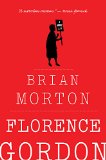Summary | Excerpt | Reading Guide | Reviews | Beyond the book | Read-Alikes | Genres & Themes | Author Bio

If you were to write down the plot of John Banville's The Blue Guitar on a sheet of paper – no, make that an index card – you'd still have plenty of room to write lots of other things: grocery lists, phone numbers, appointments, and other things that you usually keep in your head. Actually, those things you've just written down are as good a guide to the events of The Blue Guitar as the actual plot. Better, maybe, for Banville's 256-page novel isn't plot-driven at all but rather propelled by the minutiae of life as noticed and commented upon by the despairing, eloquent voice of a burned out middle-aged artist.
The Blue Guitar is narrated by a former painter named Oliver Otway Orme ("O.O.O. An absurdity. You could hang me over the door of a pawnshop.") who has lost faith in his ability to capture the essence of what he paints. That inability to create art is deflating his whole life, which now seems to plod along from one unspectacular moment to the next. What little meaning his existence might have once held has evaporated in the mists of time, a once-happy marriage giving way to an emotionally bereft and rote domestic routine, hastened into sterility by the death of a three-year old daughter several years ago. But the real tragedy in his life seems to be his current artistic crisis:
One day I saw the problem, just like that, and nothing was to be the same again. And what was the problem? It was this: that out there is the world and in here is the picture of it, and between the two yawns the man-killing crevasse.
The plot, such as it is, involves an extramarital affair that engenders more boredom than passion. In an effort to escape the fallout from the dalliance, Oliver — who lives in some unidentified Irish village — retreats to his nearby boyhood home. The Oliver we meet at the beginning, as he recounts the start of the affair, appears almost incapable of happiness, though he doesn't seem the least bit bothered by it. The only thing that gives him any joy at all is stealing things. Committing acts of petty theft fills him with "a feeling almost of holy awe." He's a brutal realist who sees the world's flaws with an artist's keen eye yet he stands above it all, commenting wryly but not really impacted by what he describes, even when it's his own life in his spotlight. It's a self-portrait of a once-impassioned artist who has lost his mojo and who now seems more content to catalog his condition than to do anything to fix it.
The Blue Guitar could more accurately be titled A Portrait of the Artist as a Middle-Aged Failure. He is James Joyce's artist-protagonist Stephen Dedalus, grown older and disillusioned. (Banville's debt to Joyce in this book is extensive, with a sly recasting of several pivotal scenes in the life of Joyce's fictional doppelganger Stephen. Joyceans will also find dozens of references to key moments in Dubliners, A Portrait of the Artist as a Young Man, and Ulysses.)
Banville, a prolific and critically regarded Irish novelist whose previous works have won some of the most prestigious literary awards, is a mesmerizing prose stylist, and that's where he triumphs here. His looping, loopy sentences and his bracing and byzantine gift for turning a phrase provide The Blue Guitar with pretty much all of its satisfactions.
Readers who have difficulty warming up to the somewhat cynical and even smug tone of the narrator might find the book a challenge, as the only perspective the reader is provided is the flippantly barbed worldview of the emotionally absent Ollie. But how can one completely resist a narrator who thinks of the rain "whispering against the window-panes with stealthy, lewd suggestiveness," or the waves that are "topped with soiled white spray and their deeply scooped, smooth undersides had a glassy and malignant shine"?
Banville is such a good writer, and The Blue Guitar so trenchantly observant (of one character, he notes that sorrow over the loss of her child "hardened about her into a carapace as impenetrable as porcelain"), that many readers might not care that almost nothing happens in the course of the novel. Others, less entranced by belles-lettres, could find their interest waning. There's a line in the Wallace Stevens poem, "The Man With the Blue Guitar," (see 'Beyond the Book') that could serve as a sort of coda, or even a summary, for the book: "And that's life, then: things as they are / This buzzing of the blue guitar." The guitar player, or artist in general, no longer transforms, or even masks, the brutal truths of life. There's nothing to do but sit on the sidelines, reconciled to the baseness of the world, life's beauty a juvenile illusion, and the once-sublime music of the spheres now a baneful buzzing in your ears.
![]() This review was originally published in The BookBrowse Review in November 2015, and has been updated for the
September 2016 edition.
Click here to go to this issue.
This review was originally published in The BookBrowse Review in November 2015, and has been updated for the
September 2016 edition.
Click here to go to this issue.

If you liked The Blue Guitar, try these:

by Jill Bialosky
Published 2016
"Like Edward feels upon discovering a transcendent piece of art, this book finds that little opening at the edge of your soul and seeps in."

by Brian Morton
Published 2015
A wise and entertaining novel about a woman who has lived life on her own terms for seventy-five defiant and determined years, only to find herself suddenly thrust to the center of her family's various catastrophes.
Your guide toexceptional books
BookBrowse seeks out and recommends the best in contemporary fiction and nonfiction—books that not only engage and entertain but also deepen our understanding of ourselves and the world around us.